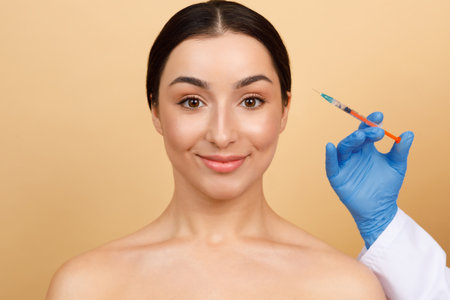1. Understanding Under-Eye Filler Migration
Under-eye filler migration occurs when the dermal filler moves away from its original injection site, leading to unwanted puffiness or uneven results. Understanding the causes of this issue is essential for both patients and providers to ensure safe and effective treatment.
Causes of Under-Eye Filler Migration
Improper Placement
If fillers are injected too superficially or in the wrong anatomical plane, they may not stay in place. The delicate skin under the eyes requires precise placement to avoid migration and unnatural swelling.
Filler Type
The type of filler used plays a crucial role in preventing migration. Some fillers are more prone to spreading due to their consistency and formulation. Choosing the right product for the under-eye area is key.
Anatomical Factors
Each individual’s anatomy affects how fillers settle. Factors such as skin laxity, muscle movement, and fat distribution can contribute to migration over time.
Comparison of Common Causes of Under-Eye Filler Migration
| Cause | Description | How to Prevent It |
|---|---|---|
| Improper Placement | Filler is injected too close to the surface or in an incorrect plane. | Select an experienced injector familiar with under-eye anatomy. |
| Filler Type | Certain fillers have a higher tendency to spread due to their texture. | Use firmer fillers designed specifically for tear trough treatments. |
| Anatomical Factors | The structure of a person’s under-eye area affects filler movement. | A thorough consultation can help determine the best approach. |
2. Choosing the Right Filler and Injector
Selecting the right filler and working with an experienced injector are two of the most important factors in preventing under-eye filler migration. The type of filler used and the skill of the injector both play a crucial role in ensuring natural-looking and long-lasting results.
Understanding Different Filler Types
Not all fillers are created equal, and using the wrong one can increase the risk of migration. For the delicate under-eye area, hyaluronic acid (HA) fillers are typically recommended because they are soft, hydrating, and reversible if needed. However, even within HA fillers, different formulations exist, each with varying levels of thickness, cohesivity, and longevity.
Comparison of Common Under-Eye Fillers
| Filler Type | Key Features | Best for Under-Eye Use? |
|---|---|---|
| Juvederm Volbella | Lightweight, smooth consistency, designed for delicate areas | Yes |
| Restylane Eyelight | Slightly firmer than Volbella, provides good structural support | Yes |
| Juvederm Voluma | Thicker gel for volume restoration | No (better for cheeks) |
| Sculptra or Radiesse | Bioresorbable fillers that stimulate collagen production | No (not reversible) |
The Importance of an Experienced Injector
A skilled injector understands facial anatomy and knows how to place filler strategically to minimize risks like migration or puffiness. They will also use precise techniques, such as injecting at the correct depth and avoiding overfilling.
What to Look for in an Injector
- Experience with Under-Eye Fillers: Choose someone who specializes in treating this delicate area.
- Keen Eye for Natural Results: A good injector will aim for subtle enhancement rather than overfilling.
- Avoids High-Risk Techniques: Proper placement and injection technique reduce the chances of migration.
- Carries Reversal Agents: If HA filler migration occurs, hyaluronidase can be used to dissolve it safely.
- Patient-Centered Approach: A great provider will listen to your concerns and create a customized treatment plan.
Avoiding Common Mistakes
Mistakes like using too much filler, injecting too superficially, or selecting an overly thick product can all contribute to unwanted movement. By choosing the right filler formulation and working with a qualified professional, you can significantly reduce these risks.
![]()
3. Proper Injection Techniques for Stability
Ensuring under-eye filler remains in place and delivers natural-looking results requires precise injection techniques. Proper depth, volume control, and strategic injection points all play a crucial role in preventing migration and achieving long-lasting effects.
Understanding the Right Depth
One of the most important factors in preventing filler migration is injecting at the correct depth. The under-eye area has delicate tissue, so fillers should be placed at an appropriate level based on the type of product used:
| Injection Depth | Best Practice |
|---|---|
| Deep (supraperiosteal) | Provides structural support and reduces risk of visible lumps or movement. |
| Mid-depth (subdermal) | May be used for blending but requires careful placement to avoid irregularities. |
| Superficial (dermal) | Avoid in tear troughs, as it increases migration risk and can cause puffiness. |
Controlling Volume to Prevent Overfilling
The under-eye area is prone to swelling, so using the right amount of filler is essential. Overfilling not only causes unnatural puffiness but also increases the likelihood of migration. A conservative approach works best, with gradual layering if additional volume is needed.
Selecting Strategic Injection Points
The placement of filler should follow the natural contours of the face to ensure even distribution and stability. Common strategic injection points include:
- Tear trough region: Injecting precisely along the tear trough helps correct hollowness without creating excess fullness.
- Lateral cheek area: Supporting the midface with filler can reduce strain on the under-eye area and improve longevity.
- Avoiding direct injections into mobile areas: Placing filler too close to dynamic regions like the lower eyelid can lead to movement over time.
A skilled injector will tailor these techniques to each patient’s unique anatomy, ensuring optimal results while minimizing risks.
4. Post-Treatment Care to Reduce Migration
Proper aftercare is essential to ensure your under-eye filler stays in place and delivers the best results. Following a few simple guidelines can help minimize the risk of migration and prolong the effects of your treatment.
Avoid Excessive Pressure
One of the most important things to remember after getting under-eye fillers is to avoid putting too much pressure on the treated area. Excessive pressure can cause the filler to shift, leading to uneven results.
Things to Avoid:
- Rubbing or massaging the under-eye area
- Sleeping face-down or on your side
- Wearing tight goggles or eye masks
Minimize Facial Movements
Your facial expressions can also impact how well the filler settles. Try to keep exaggerated movements to a minimum for the first few days after treatment.
Recommended Precautions:
| Avoid | Alternative |
|---|---|
| Laughing excessively | Keep facial expressions gentle |
| Crying or rubbing eyes | Dab gently with a tissue if needed |
| Intense workouts | Opt for light activity like walking |
Follow Professional Guidance
Your provider will give you specific instructions based on your unique treatment plan. Always follow their advice to ensure safe healing and optimal results.
Key Aftercare Tips from Professionals:
- Avoid alcohol and blood-thinning medications for at least 24 hours
- Use cold compresses to reduce swelling, but avoid direct pressure
- If you experience any unusual lumps or prolonged swelling, consult your injector immediately
Taking proper care of your under-eye fillers in the days following your appointment can make a significant difference in how well they settle and how long they last. By being mindful of pressure, facial movements, and professional advice, you can enjoy smoother, natural-looking results.
5. Managing and Correcting Filler Migration
Identifying Early Signs of Filler Migration
Recognizing under-eye filler migration early can help prevent further complications. Some common signs to watch for include:
- Swelling or Puffiness: If the treated area appears more swollen than expected, especially weeks after treatment.
- Lumps or Uneven Texture: Small bumps or uneven distribution of the filler may indicate migration.
- Blue or Tyndall Effect: A bluish tint under the skin can be a sign that filler has moved too close to the surface.
- Changes in Contour: If the under-eye area looks unnatural or bulging, migration could be the cause.
Corrective Treatments for Filler Migration
If migration occurs, several corrective options are available depending on the severity of the issue. A qualified provider can assess the situation and recommend an appropriate solution.
| Treatment Option | Description | When to Consider |
|---|---|---|
| Hyaluronidase Injections | An enzyme that dissolves hyaluronic acid-based fillers, allowing for a reset of the area. | If significant migration has occurred and needs to be reversed. |
| Manual Adjustment by Provider | A skilled injector may be able to massage or redistribute minor filler movement. | If migration is minimal and can be corrected without dissolving the filler. |
| Addition of More Filler (Carefully) | In some cases, a small amount of additional filler can balance out irregularities. | If slight asymmetry exists but dissolving is not necessary. |
| Waiting for Natural Dissipation | Hyaluronic acid fillers gradually break down over time, so mild cases may resolve naturally. | If the migration is subtle and does not cause major aesthetic concerns. |
The Importance of Consulting a Qualified Provider
If you suspect filler migration, always consult an experienced injector rather than attempting to fix it yourself. A trained professional can determine whether adjustments or dissolving agents are needed, ensuring a safe and effective correction process.
What Not to Do:
- Avoid excessive massaging of the area unless instructed by your provider.
- Do not attempt DIY dissolving methods with unverified products.
- Refrain from getting additional treatments until a professional evaluates your situation.
Preventing Future Filler Migration
Once corrections have been made, consider steps to prevent future migration, such as choosing an experienced injector, using the right type of filler, and following proper aftercare instructions. By taking these precautions, you can achieve long-lasting and natural-looking results.
If youre experiencing any signs of filler migration, schedule a consultation with a qualified provider as soon as possible to explore your best corrective options.

